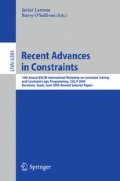Abstract
Dynamic Backtracking (DBT) is a well known algorithm for solving Constraint Satisfaction Problems. In DBT, variables are allowed to keep their assignment during backjump, if they are compatible with the set of eliminating explanations. A previous study has shown that when DBT is combined with variable ordering heuristics, it performs poorly compared to standard Conflict-directed Backjumping (CBJ) [Bak94]. In later studies, DBT was enhanced with constraint propagation methods. The MAC-DBT algorithm was reported by [JDB00] to be the best performing version, improving on both standard DBT and on FC-DBT by a large factor.
The present study evaluates the DBT algorithm from a number of aspects. First we show that the advantage of MAC-DBT over FC-DBT holds only for a static ordering. When dynamic ordering heuristics are used, FC-DBT outperforms MAC-DBT. Second, we show theoretically that a combined version of DBT that uses both FC and MAC performs equal or less computation at each step than MAC-DBT. An empirical result which presents the advantage of the combined version on MAC-DBT is also presented. Third, following the study of [Bak94], we present a version of MAC-DBT and FC-DBT which does not preserve assignments which were jumped over. It uses the Nogood mechanism of DBT only to determine which values should be restored to the domains of variables. These versions of MAC-DBT and FC-DBT outperform all previous versions.
Access this chapter
Tax calculation will be finalised at checkout
Purchases are for personal use only
Preview
Unable to display preview. Download preview PDF.
References
Baker, A.B.: The hazards of fancy backtracking. In: Proceedings of the 12th National Conference on Artificial Intelligence (AAAI 1994), Seattle, WA, USA, July 31 - August 4, vol. 1, pp. 288–293. AAAI Press, Menlo Park (1994)
Bessière, C., Freuder, E., Régin, J.: Using inference to reduce arc consistency computation. In: IJCAI 1995, pp. 592–598 (1995)
Bessière, C., Regin, J.C.: Mac and combined heuristics: two reasons to forsake fc (and cbj?) on hard problems. In: Freuder, E.C. (ed.) CP 1996. LNCS, vol. 1118, pp. 61–75. Springer, Heidelberg (1996)
Chen, X., van Beek, P.: Conflict-directed backjumping revisited. Journal of Artificial Intelligence Research (JAIR) 14, 53–81 (2001)
Dechter, R.: Constraint Processing. Morgan Kaufman, San Francisco (2003)
Dechter, R., Frost, D.: Backjump-based backtracking for constraint satisfaction problems. Artificial Intelligence 136(2), 147–188 (2002)
Ginsberg, M.L.: Dynamic backtracking. J. of Artificial Intelligence Research 1, 25–46 (1993)
Gent, I.P., Walsh, T.: Csplib: a benchmark library for constraints. Technical report, Technical report APES-09-1999 (1999), http://csplib.cs.strath.ac.uk/ ; A shorter version appears in the Proceedings of the 5th International Conference on Principles and Practices of Constraint Programming (CP 1999)
Haralick, R.M., Elliott, G.L.: Increasing tree search efficiency for constraint satisfaction problems. Artificial Intelligence 14, 263–313 (1980)
Jussien, N., Debruyne, R., Boizumault, P.: Maintaining arc-consistency within dynamic backtracking. In: Dechter, R. (ed.) CP 2000. LNCS, vol. 1894, pp. 249–261. Springer, Heidelberg (2000)
Kondrak, G., van Beek, P.: A theoretical evaluation of selected backtracking algorithms. Artificial Intelligence 21, 365–387 (1997)
Mohr, R., Henderson, T.C.: Arc and path consistence revisited. Artif. Intell. 28(2), 225–233 (1986)
Prosser, P.: Hybrid algorithms for the constraint satisfaction problem. Computational Intelligence 9, 268–299 (1993)
Prosser, P.: An empirical study of phase transitions in binary constraint satisfaction problems. Artificial Intelligence 81, 81–109 (1996)
Smith, B.M.: Locating the phase transition in binary constraint satisfaction problems. Artificial Intelligence 81, 155–181 (1996)
Author information
Authors and Affiliations
Editor information
Editors and Affiliations
Rights and permissions
Copyright information
© 2011 Springer-Verlag Berlin Heidelberg
About this paper
Cite this paper
Zivan, R., Shapen, U., Zazone, M., Meisels, A. (2011). MAC-DBT Revisited. In: Larrosa, J., O’Sullivan, B. (eds) Recent Advances in Constraints. CSCLP 2009. Lecture Notes in Computer Science(), vol 6384. Springer, Berlin, Heidelberg. https://doi.org/10.1007/978-3-642-19486-3_9
Download citation
DOI: https://doi.org/10.1007/978-3-642-19486-3_9
Publisher Name: Springer, Berlin, Heidelberg
Print ISBN: 978-3-642-19485-6
Online ISBN: 978-3-642-19486-3
eBook Packages: Computer ScienceComputer Science (R0)

